EUROPEAN CETACEAN BYCATCH CAMPAIGN
"Man is but a strand in the complex web of life"
"Man is but a strand in the complex web of life"
The highest bycatch catch rate per hour of towing was recorded in the French sea bass fishery.
http://www.ifremer.fr/drvrhbr/action_recherche/rejets_mer/chalut_pelagique/index.htm#Signet6
Although this study describes the capture of a marine mammal in a trawl fishery as a 'rare event', given the size of the European fleet and the amount of fishing effort, the total numbers of animals caught poses a serious threat to certain dolphin populations.
(Please see pages 20 - 28 of linked publication)
http://www.ices.dk/reports/ACE/2001/wgmmph01.pdf
In this report, as in many others, it stated that the study was compromised as some fishing fleets refused to permit observers to board their vessels.
There is no legislation in the UK or the other participating countries (France, Ireland, Netherlands) to enforce co-operation with observers.
It also stated that bycatch estimates should be treated as a minimum, as the study was compromised by, the use of fish pumps in some fisheries, which prevented the observers recording all marine mammal bycatches.
However, given that dolphin flesh appeared on the decks of vessels using these, it would seem reasonable to suggest that dolphins were in the nets. In addition, in the UK mackerel and pilchard trawl fisheries, the cod-end was emptied out-board, therefore preventing observers from seeing any bycaught cetaceans.
Evidence of the level of cetacean bycatch in pelagic trawl fisheries is seen on European beaches.
February 1989: 600 dolphins stranded in two days in Landes and Vendee, on the French Atlantic coast. This event was thought to be a result of entanglement in pelagic trawls, as many of the bodies showed signs of incidental capture. January - April 1992: 118 dolphins (of which nearly half were positively identified as common dolphins) stranded in Devon and Cornwall.
This was attributed to the pelagic fisheries which are active in the Western Approaches at that time of year, fishing for mackerel, horse mackerel, sea bass and pilchard, as the vast majority showing signs of entanglement in trawl nets.
Kuiken et al. (1994) identified pelagic trawling for mackerel and pilchard as the most likely cause of
the mass mortality of common dolphins in Devon and Cornwall 1992/1993.
The same fisheries were thought to be responsible for similar strandings of common and white-sided
dolphins off the south and west coasts of Ireland.
Fishery interactions were identified as the main cause of death of stranded harbour porpoises in the UK by Baker and Martin (1992).
Pelagic trawling for herring was thought to be responsible for harbour porpoise strandings off the southern Irish coast (Berrow and Rogan, 1997).
February - March 1997: in a three week period 629 dolphinsstranded on the Southern Brittany and Biscay coasts.
This event was thought to be a result of entanglement in pelagic trawls, as many of the bodies showed signs of incidental capture.
During 1998 and 1999, 4 pairs of Irish pelagic pair trawlers were monitored whilst fishing for tuna in the waters off the southwest coast of Ireland and in the Bay of Biscay.
In 313 hauls, a total of 145 cetaceans were taken - 127 common dolphins, 8 striped dolphins, 2 Atlantic white-sided dolphins and 8 pilot whales.
30 cetaceans were taken in a single haul.
February - March 2000 - ( El Azuelo V5 p5 ): in excess of 600 dolphins stranded on the coasts of Cornwall, Devon and Brittany. This event was thought to be a result of entanglement in French and Scottish pair trawls, used to catch sea bass in the Western Approaches, as many of the bodies showed signs of incidental capture
In a BBC programme (March 2000) a Scottish trawler skipper from Fraserburgh stated that several dolphins had died in his nets
A CEFAS observer recorded a bycatch of 15 dolphins, over nine days at sea, onboard a UK pelagic trawler.
The video footage was subsequently destroyed.
CEFAS is the Centre for Environment, Fisheries and Aquaculture Science
Fisheries Minister, Mr. Elliot Morley, stated that there had been video footage of dolphins in nets, but that it had been destroyed.
He also stated "This is a breakthrough in terms of our observers being there. It is the first time we have had real evidence about bycatch. We know that trawlers are killing dolphins, and as far as I am concerned we have got enough evidence to take action and we intend to do that".
It was estimated that during the months January - March, 2000 - 3000 dolphins died due to entanglement in the nets of pair trawlers fishing for sea bass in the English Channel / Western Approaches.
The countries using this method of fishing in the Western Approaches are Scotland, England, Ireland, France, Denmark, and the Netherlands.
When 116 hauls of the UK pelagic sea bass fishery were observed by the Sea Mammal Research Unit during 2000 and 2001, 53 dolphins were caught in 12 hauls, 20 of which were caught in a single haul.
The UK Minster for Fisheries has stated that no dolphins were caught in the herring, mackerel, pilchard, sprat, blue whiting, and anchovy fisheries.
This is not surprising given the number of hauls that were observed, ranging from 3 to 42, as compared to 116 for sea bass. Cetacean bycatch in pelagic trawls in not consistent. A significant number of hauls must be observed to obtain the relevant data.
This was not done, and therefore it is it is not credible to suggest that these fisheries do not entangle dolphins, given that a number of scientific studies clearly show that the afore mentioned fisheries have unacceptable levels of cetacean bycatch.
Top
http://www.ifremer.fr/drvrhbr/action_recherche/rejets_mer/chalut_pelagique/index.htm#Signet6
Although this study describes the capture of a marine mammal in a trawl fishery as a 'rare event', given the size of the European fleet and the amount of fishing effort, the total numbers of animals caught poses a serious threat to certain dolphin populations.
(Please see pages 20 -
http://www.ices.dk/reports/ACE/2001/wgmmph01.pdf
In this report, as in many others, it stated that the study was compromised as some fishing fleets refused to permit observers to board their vessels.
There is no legislation in the UK or the other participating countries (France, Ireland, Netherlands) to enforce co-
It also stated that bycatch estimates should be treated as a minimum, as the study was compromised by, the use of fish pumps in some fisheries, which prevented the observers recording all marine mammal bycatches.
However, given that dolphin flesh appeared on the decks of vessels using these, it would seem reasonable to suggest that dolphins were in the nets. In addition, in the UK mackerel and pilchard trawl fisheries, the cod-
Evidence of the level of cetacean bycatch in pelagic trawl fisheries is seen on European beaches.
February 1989: 600 dolphins stranded in two days in Landes and Vendee, on the French Atlantic coast. This event was thought to be a result of entanglement in pelagic trawls, as many of the bodies showed signs of incidental capture. January -
This was attributed to the pelagic fisheries which are active in the Western Approaches at that time of year, fishing for mackerel, horse mackerel, sea bass and pilchard, as the vast majority showing signs of entanglement in trawl nets.
Kuiken et al. (1994) identified pelagic trawling for mackerel and pilchard as the most likely cause of
the mass mortality of common dolphins in Devon and Cornwall 1992/1993.
The same fisheries were thought to be responsible for similar strandings of common and white-
dolphins off the south and west coasts of Ireland.
Fishery interactions were identified as the main cause of death of stranded harbour porpoises in the UK by Baker and Martin (1992).
Pelagic trawling for herring was thought to be responsible for harbour porpoise strandings off the southern Irish coast (Berrow and Rogan, 1997).
February -
This event was thought to be a result of entanglement in pelagic trawls, as many of the bodies showed signs of incidental capture.
During 1998 and 1999, 4 pairs of Irish pelagic pair trawlers were monitored whilst fishing for tuna in the waters off the southwest coast of Ireland and in the Bay of Biscay.
In 313 hauls, a total of 145 cetaceans were taken -
30 cetaceans were taken in a single haul.
February -
In a BBC programme (March 2000) a Scottish trawler skipper from Fraserburgh stated that several dolphins had died in his nets
A CEFAS observer recorded a bycatch of 15 dolphins, over nine days at sea, onboard a UK pelagic trawler.
The video footage was subsequently destroyed.
CEFAS is the Centre for Environment, Fisheries and Aquaculture Science
Fisheries Minister, Mr. Elliot Morley, stated that there had been video footage of dolphins in nets, but that it had been destroyed.
He also stated "This is a breakthrough in terms of our observers being there. It is the first time we have had real evidence about bycatch. We know that trawlers are killing dolphins, and as far as I am concerned we have got enough evidence to take action and we intend to do that".
It was estimated that during the months January -
The countries using this method of fishing in the Western Approaches are Scotland, England, Ireland, France, Denmark, and the Netherlands.
When 116 hauls of the UK pelagic sea bass fishery were observed by the Sea Mammal Research Unit during 2000 and 2001, 53 dolphins were caught in 12 hauls, 20 of which were caught in a single haul.
The UK Minster for Fisheries has stated that no dolphins were caught in the herring, mackerel, pilchard, sprat, blue whiting, and anchovy fisheries.
This is not surprising given the number of hauls that were observed, ranging from 3 to 42, as compared to 116 for sea bass. Cetacean bycatch in pelagic trawls in not consistent. A significant number of hauls must be observed to obtain the relevant data.
This was not done, and therefore it is it is not credible to suggest that these fisheries do not entangle dolphins, given that a number of scientific studies clearly show that the afore mentioned fisheries have unacceptable levels of cetacean bycatch.
Top
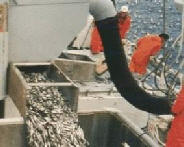
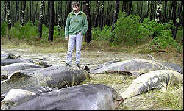
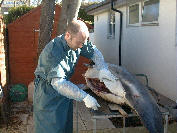
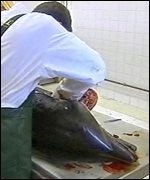
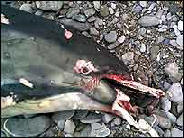
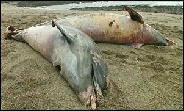
“Three species of marine mammal were definitely by-caught (white-sided dolphin Lagenorhynchus acutus, common dolphin Delphinus delphis and grey seal Halichoerus grypus) and probably also a bottlenose dolphin Tursiops truncatus. Dolphins were caught in four of the eleven fisheries and seals in one”. - Morizur et al 1999
Abstract Morizur et al 1999
Incidental catches of marine mammals in pelagic trawl fisheries of the Northeast Atlantic.
Fisheries Research 41, 297-307
Incidental catches of marine mammals in pelagic trawl fisheries of the Northeast Atlantic.
Fisheries Research 41, 297-